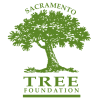Mulch materials ranked from best to worst
by Stephanie Robinson
September 8, 2021
If you’re mulching your trees, chances are you’re hoping to give your trees a boost. Mulch can set the stage for healthy soil that in turn grows healthy trees, but some types of mulch can do more harm than good. Here’s a ranking of different types of mulch, from best to worst.
BEST
Natural wood chips

Also known as arborist wood chips, this mulch is made of all parts of a tree – leaves, twigs, bark, and wood. When applied in a layer 4-6 inches thick, the uneven size of wood chips allow them to lock together and form a thick mat that blocks weeds, retains soil moisture, and insulates roots from extreme temperatures. It also improves soil over time — loosening compaction, feeding beneficial soil microbes, and providing nutrition for your tree. Bonus points if a 1-inch layer of compost is applied directly on top of soil underneath the wood chips!
OKAY
Shredded leaves, straw, lawn clippings, compost, etc.
Organic materials like leaves will break down over time, enriching the soil, encouraging a healthy soil microbiome, and feeding your tree. They are best when combined with heavier organic matter like wood chips. Only use weed-free sources.
Bark
Bags of bark you can buy from garden centers and landscaping suppliers include chunks of the tree’s outer bark. This waxy, water resistant part of the tree does not break down as easily as wood chips, so it does not improve the soil as much. While bark does help conserve some moisture, it doesn’t lock together to get the best water savings and weed prevention. If you prefer the look of bark, consider applying 3-4 inches of wood chips, then topping off with 1 inch of bark.
Cardboard
Sometimes used in a turf removal method called sheet mulching or lasagna mulching, thick mats of cardboard are layered with newspaper underneath wood chips to smother grass naturally. While the cardboard eventually breaks down to enrich the soil, it can prevent water from reaching tree roots. If using this method, choose cardboard that is unwaxed and free of plastic or staples. Be sure to thoroughly soak the soil before applying cardboard, and soak each layer of cardboard as well. Periodically check the soil underneath to ensure that water is still reaching the roots all around the tree’s drip line.
NOT IDEAL
Grass
Grass competes with tree roots for water and nutrients, and it secretes chemicals that inhibit tree growth. Additionally, trees have different water requirements than grass, needing a slower and deeper soak to grow strong and healthy (and some trees, like native trees that are adapted to dry summers, could be harmed by summer turf irrigation). If you want your young trees to grow fast, keep grass away from their root zones. Mature trees that have grown up surrounded by grass won’t be harmed by it, but if you stop watering your lawn to conserve water, make sure you still occasionally deep water your trees.
Permeable landscape fabric
Landscape fabric that allows water to pass through can initially block some weeds and still allow water to reach tree roots. However, some weeds like nutsedge and Bermuda grass will grow directly through landscape fabric. And as leaves, mulch, dust, and other organic materials accumulate and break down on top of landscape fabric, weeds are able to germinate in this top layer anyway. Unfortunately for the tree that would benefit greatly from this organic matter, the fabric serves as a barrier that prevents nutrients from cycling back into the soil.
BAD
Artificial turf
Artificial turf is made of plastic, which can heat the soil, increase water needs of trees, and block organic matter from breaking down to feed the soil and tree roots.
WORST
Rocks and gravel
Among the worst offenders for tree mulch are rocks and gravel. Instead of conserving moisture, they heat up the soil, making tree roots thirsty and stressed. Their weight slowly compacts soil over time, and they provide no soil health benefits.
Decomposed granite

DG is made of fine crushed granite and is a common material in many water wise landscapes and native plant gardens. While attractive, its installation typically requires compacting and/or grading the soil, which harms existing tree roots and provides poor soil conditions for new trees. Since it is made of rock, it increases summer soil temperatures, and unlike organic materials like wood chips, it provides no soil nutrition as it breaks down. Sometimes stabilizers are added to bind the material together and form a concrete-like surface, which makes it impossible for water to reach tree roots.
Plastic weed block
Similar to permeable landscape fabric but worse, plastic weed block prevents water from reaching tree roots. Like the other worst mulch materials, it subjects tree roots to extreme heat and prevents nutrients from cycling back into the soil. And since organic matter breaks down on top of it, weed seeds easily germinate in the accumulated debris on top.
Rubber
Sometimes sold as bagged mulch, rubber provides no soil-building benefits and heats up root zones.
How to mulch your trees
Whichever type of mulch you use, keep in mind that even the best mulch can harm your tree if applied the wrong way. Add mulch in a fluffy donut shape around your tree 6 inches thick, and keep it 4 inches away from the trunk. For best results, expand the mulch outward as the tree grows to cover the area underneath the canopy.
Check out our mulch guide to learn more and find ways to get free wood chips.
